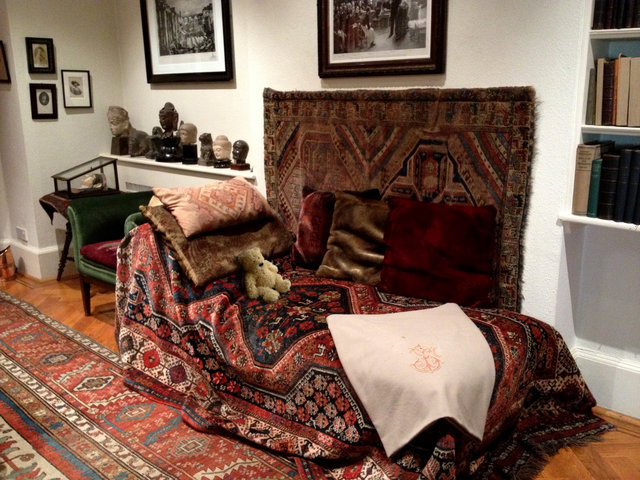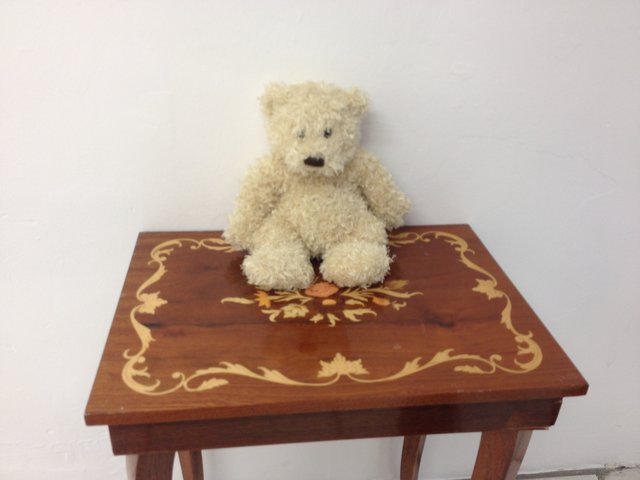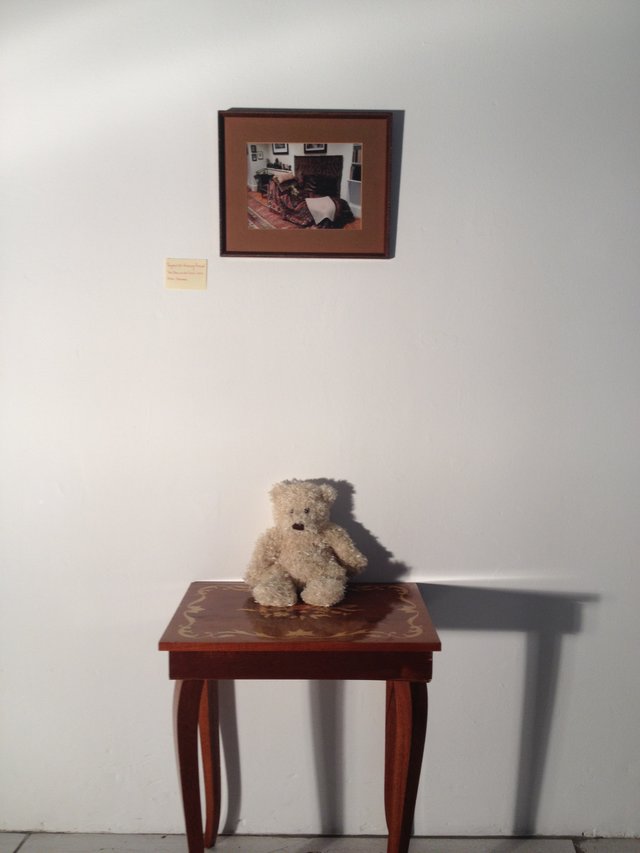Performances
Writing & other encounters
Content types
Tags
- Plays (7)
- Warlike Collage (3)
- The Dybbuk (3)
- Twenty Two Pictures (3)
- Cheruta (3)
- Grace (3)
- Ruthie Osterman (2)
- Theatre du soleil (1)
- Arian Mnushkin (1)
- Iphigenia in Aulis (1)
- Euripides (1)
- Sophocles (1)
- Antigone (1)
- Performance Practices & Research (1)
- I am. I am. I am (1)
- ZSPERA'42 (1)
- Postal Delivery to God (1)
- Babylon Beyond Borders (1)
- Bush Theatre (1)
- Live Stream (1)
- Up Next (1)
Links
Links
Beyond the archiving principle
Freudian reflections on the archive
Ruthie Osterman, London , 2013.

“It is to burn with a passion.”
(Derrida, Archive Fever, 1996:91)
In this essay I would like to analyze an artefact that I created as part of my ‘Archiving Practice’ unit in the Royal Central School of Speech and Drama by using Freud’s notion of the ‘uncanny’ (1919) and the philosopher Jacques Derrida‘s understanding of the archive as it is presented in his book Archive Fever – A Freudian Impression. Through describing and analyzing the process of creating my artefact, I will present the way I see the archive as an open, inviting and even chaotic space of encounter.
In May 2013 as part of an ‘Archiving Practice’ unit in my MA studies in London, I visited ‘Freud Museum’ for the first time. I was overwhelmed by the place and Freud’s collections, having a weird feeling that this place is familiar and unfamiliar to me at the same time. It was forbidden to photograph in the house; nevertheless, I took pictures of almost everything in the house, thinking that it is probably the best place to give freedom to my sins. (I also thought to myself that if I get caught, I will immediately lie down on the couch, ready for my psychoanalysis …) When I observed the photos I started to see and imagine things in the archive which did not really exist there. I saw my old Teddy-bear from my childhood lying-down on Freud’s couch as if it were the perfect place for it. At that moment I thought about things in the archive which do not really belong to the archive but still exist within it. They belong and don’t belong at the same time; to use Freud’s word they are ‘uncanny’ in the archive.
“At that moment I realised that there is a hierarchy within the archive and that someone should ‘take care’ and be the guard of the archive. It made me think about the inner-archive, and when I say ‘inner- archive’ I mean memory; I mean the body. Does the inner-archive have a guard too? Who controls the inner-archive and doesn’t let strange things get in? Who is the visitor of the inner-archive and what is he doing there?”
Freud, in his essay ‘The Uncanny’ (1919), explains that ‘the uncanny is that class of the terrifying which leads back to something long known to us, once very familiar.’ (Electronic version, p: 1) It is something which is unknown yet familiar at the same time. This expresses quite well the feeling that I had when I entered the Freud Museum. What caused this feeling? Freud said that ‘Something has to be added to what is novel and unfamiliar to make it uncanny’ (ibid). It is not by chance that I felt uncanny in Freud’s House. The word ‘unheimlich’ is the opposite of ‘heimlich’ which in German means ‘belonging to the home’. What kind of home/house/museum is the Freud Museum?
I decided to ‘catch that moment’ of my encounter with this archive and to ask for permission to photograph my old teddy-bear on Freud’s couch, just as I saw it in my imagination.
I will deliberate later in this essay the way I read and understand ‘archive’ as a space of encounter and performance within the archive. I wanted to create an artefact which plays with the possibilities of the archive and brings together two significant elements from two different archives: the old teddy bear from my private archive and Freud’s couch from the Freud Museum. (a public archive)
I went to the Freud Museum to introduce my idea and I was asked to contact the curator of the Museum, Miss Sophie Leighton, and the producer of the Museum, Miss Bryony Davies, through email. I did so(see appendix 1 ). I got no response. A week later, I returned to the Museum and waited in front of its main door before opening time for someone to talk to. I brought my teddy-bear with me, thinking that I might find some way to insert the teddy-bear into the house.
A man, whose position in the museum was unknown to me, was the first person to come in and I took the opportunity to ask his permission to photograph my teddy bear on Freud’s couch. He asked me a lot of questions and was very interested in my idea. After my explanation, he told me that he doesn’t think that I will be able to photograph my teddy bear on Freud’s couch but I might be able to photograph it on Anna Freud’s couch on the second floor. He explained that ‘She used to work with children and the teddy bear is from your childhood so it’s the right place’. I disagreed and told him that I was interested in putting the teddy bear only on Freud’s couch. After his failed attempts to convince me that I am actually speaking about ‘Transitional object’ or ‘forced memory’, he asked Bryony, the producer of the Museum, to come and speak with me. She explained to me the politics of the Museum, its hierarchy and why I will not be able to take this photo:
“The Couch is so precious, it is an icon and we cannot let people put things on the couch. You know, even me and Sophie (the curator), we don’t even touch the couch”
At that moment I realised that there is a hierarchy within the archive and that someone should ‘take care’ and be the guard of the archive. It made me think about the inner-archive, and when I say ‘inner- archive’ I mean memory; I mean the body. Does the inner-archive have a guard too? Who controls the inner-archive and doesn’t let strange things get in? Who is the visitor of the inner-archive and what is he doing there?
I see myself as a live archive and sometimes I can find objects, thoughts or even feelings within this archive, which do not belong to it, which do not belong to me. However, they are there. I might call them ’the uncanny in my private/inner archive’. They belong and do not belong at the same time. Yet who put them there?
I was standing in front of the producer of the Freud Museum, trying to explain to her my encounter with the archive, trying to fight for preserving the beautiful and intimate moment that I had with the archive when I saw the image of my teddy bear on the couch at the first time; but for her, the archive is closed.
I thought about Jacques Derrida coming to this house on June 4 1994, speaking about his understanding of an archive:
“As much and more than a thing of the past, before such a thing, the archive should call into question the coming of the future … it is a question of the future, the question of the future itself, the question of a response, of a promise and of a responsibility for tomorrow”
(Derrida, 1996:34-36)
Derrida, in his book Archive Fever, explains that the archive is thus not merely a question of the past. The archive is not closed, but always marked by the openness to the future. It is a question of a response. I agree with him and therefore for me the archive always holds an invitation.
I see the archive as a place for an encounter. If I had to refer to the archive as a character in a play, I would say that its main action is waiting, like a lover for his beloved. The archive is actually waiting for a partner; it’s thirsty for a relationship with the one who will come to visit it. The archive holds the past but also hold some promise for the future.
Derrida said that the archive’s biggest secret is that it’s not static. He spoke about the archive’s own performance. ‘The archive folds the past into a differed time of much future work’ (ibid) It suggests a future for the past.
I think that the archive and the act of archiving play a very interesting role in our life due to the deep connection to existential issues such as death and life. I do agree with Derrida that there is a complexity within the notion of archiving; on one hand there is a passion for the archive, as Derrida said, ‘it is to burn with a passion’ (1996:91) but on the other hand, there is some desire to destroy the archive, a ‘death drive’ within it which creates both actions:
“It is to burn with a passion. It is never to rest, interminably, for searching for the archive right where it slips away. It is to run after the archive, even if there is too much of it, right where something in it an archives itself. It is to have a compulsive, repetitive, and nostalgic desire for the archive, an irrepressible desire to return to the origin, a homesickness, a nostalgia for the return to the most archaic place of absolute commencement.”
(Derrida, Archive Fever, 1996:91)
The archive evokes longing and passion and in my case in the Freud Museum, the archive evoked also something uncanny. Derrida speaks about ‘homesickness’ and fever and therefore I think that it is not by chance that I felt the ‘uncanny’ which has something threatening within it: the desire to preserve the archive and also to destroy it at the same time. There is a tension driven by the ‘death drive’. How should I read my desire to combine these two elements, my teddy bear and the couch, as preserving or as destroying? Maybe both. Was my passion for photographing my teddy bear on the couch actually to offer chaos to the archive? Walter Benjamin in his essay Unpacking my Library says that ‘every passion borders on the chaotic, but the collector’s passion borders on the chaos of memories’ (1999:60) I think that what I saw in the Freud Museum was a chaos of memories, which invited me to add something from my own memory to that chaos.

The producer almost threw me out of the house when the man came back and started to ask more questions. He was very interested in the results of our conversation and tried to keep it up. He asked me:
“Do you have your teddy bear with you?”
At that moment I was very embarrassed, but I answered:
“Yes.”
“Can I see it?”
“Yes.”
I took out the teddy bear from my bag and showed it to the man. It was a very revealing moment. I realized what I was offering to the archive and how private and intimate was my meeting with it. I stupidly apologised:
“It’s a very simple teddy bear.”
The man took the teddy bear and said:
“I don’t think it fits the couch at all; it is much more suited to Freud’s collection”
Without thinking a lot, he took the teddy bear and went with him to the other side of the room. He started to move Freud’s small sculptures and put my teddy bear on the shelf between them. I thought to myself ‘that’s it, you are already in the archive; the performance of the archive has already started’.
“What do you think?”
I didn’t have time to answer, with the producer lowering the teddy bear off the shelf and giving it to me. She said:
“As I told you, I need to speak with Sophie, the curator, and we will send you an answer through email. Please don’t just turn up here as you did today. We will send you an answer. “
Did she realize that she was actually offering me another form of archiving? That the email itself has so much to do with archiving, as Derrida suggested nine years ago in the same lecturer? Probably not. She wanted to see me, my teddy-bear and maybe also her colleague out of the Museum. We had interrupted the silence of the archive enough for today.
On my way out the man told me:
“You should use Photoshop. You are speaking about ‘forced memory’ and not about reality. What really happened is not important. You see your teddy-bear on the couch; it doesn’t have to be there.”
When I was leaving the house, I thought about the politics and power within the archive. Derrida mentioned the Greek word ‘arkhe’ (αρχε ) for an archive, which holds a double meaning of commencement and commandment (1996). There is an issue of power and order within the archive and a question of who controls the archive. Is the archive a private or a public space? Derrida spokes about the ‘institutional passage from the private to the public’ (1996:10) when Freud’s house became a museum. But I decided not to focus my work on politics and power, although they will always be there. I wanted to stay close to the intimacy and the possibilities the archive offered me.
I thought about the form of archiving. I wanted to take a photo. Why? What was there in photography as a way of archiving that interested me?
For me, a photograph is always about killing the present, transforming it into the past and giving it a future. To use Roland Barthes’s words, the photograph is “vertigo of time” (1993:97) when you observe something which was so alive, but is already dead. Barthes also expresses the intimacy and the erotic that the archive creates when you wish to be alone with it “I need to be alone with the photographs I am looking at.” (ibid). I feel the same when I enter an archive and am highly aware of the people, if there are any, who experience the archive with me.
Derrida pointed out the importance of the form of archiving and the way it influences the content of the archive itself, because archiving is not only to preserve; it’s to produce something new ’The archivization produces as much as it records the event” (1996:17).
I decided to accept the man’s suggestion and use Photoshop, to change the way of archiving and maybe offer a new life to the archive by doing that. Derrida said that ‘what is no longer archived in the same way is no longer lived in the same way’ (Derrida 1996:18).I realized that I had to go beyond the archiving principle of documenting what really happened in the past and to create my artefact which documents my unique encounter with this archive, with the Freud Museum, while part of this encounter was the limitation of not being able to take a photo of my teddy bear on the couch and the imaginary space where it happened.
I know that my teddy bear was on the couch; it is still on the couch. As I mentioned before, the performance of the archive had already started. I took another offering of Freud himself to go ‘beyond the pleasure principle’ and I went beyond the archiving one. It was a pleasure.
 The Artefact “Beyond the archiving principle” presented at the C4CC (Centre for Creative Collaboration), London, 2013.
The Artefact “Beyond the archiving principle” presented at the C4CC (Centre for Creative Collaboration), London, 2013.
Bibliography
Barthes, R. (1993) Camera lucida : reflections on photography. London: Vintage.
Benjamin, W (1999) Illuminations: Unpacking my Library. London. Pimlico
Derrida, J. and Prenowitz, E. (tr.) (no date) Archive fever : a Freudian impression. Chicago: University of Chicago Press.
Freud, S. The Uncanny. An electronic version: http://web.mit.edu/allanmc/www/freud1.pdf
Freud, S. and Phillips, A. (ed.) (2006) The Penguin Freud reader. London: Penguin. (Penguin classics).
Links:
Derrida, J. Archive fever : a Freudian impression
Benjamin, W. Unpacking my Library


